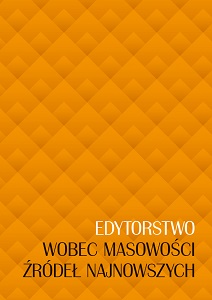Nieznośne natręctwo nikomu niepotrzebnych papierów – karty pomiarowe poborowych
The unbearable compulsion of redundant papers: the measuring cards of soldiers and draftees to the Polish Army, 1921–1939
Author(s): Michał Kopczyński
Subject(s): History
Published by: Wydawnictwa Uniwersytetu Warszawskiego
Keywords: measuring cards of soldiers; draftees to the Polish Army; interwar period; race structure of the Second Republic of Poland; body dimensions; database
Summary/Abstract: Historical sources are often divided into two broad categories: individual and occurring on a mass scale. Individual sources, like annals, chronicles, privileges or treaties, have always been made in view of the present and posterity. In contradistinction, mass sources are utilitarian in character; they are made for here-and-now. As a result, archivists and editors of historical sources often treat mass sources with neglect. The only way to regain identity leads through individualisation, like it sometimes happens with birth, marriage or death certificates found in the archives by genealogists. The subjects described in the present paper, i.e. soldiers and draftees measured by conscription authorities between 1921 and 1939, have no chance to be individualised. Nobody would look for the ancestors in such haphazard documents. The purpose for the creation of the measuring cards of draftees and soldiers analysed in the present paper has been twofold. The practical aspect was to collect body dimensions for military tailors and shoemakers; the scientific one was, in turn, to characterise the population of the Second Republic of Poland for the race structure. Both purposes are outdated, in terms of today’s perspective. Nonetheless, the documents contain important information, unavailable in other sources. The young men’s height and body mass data render us better acquainted with the standard of living in the Second Republic, a problem that still awaits research. A classical, printed, edition of the cards in question seems pointless: a single card has no cognitive value. It seems, instead, that a proper editorial approach would be to compile a database comprising all 60,000 cards.
Book: Edytorstwo wobec masowości źródeł najnowszych
- Page Range: 121-143
- Page Count: 23
- Publication Year: 2018
- Language: Polish
- Content File-PDF

